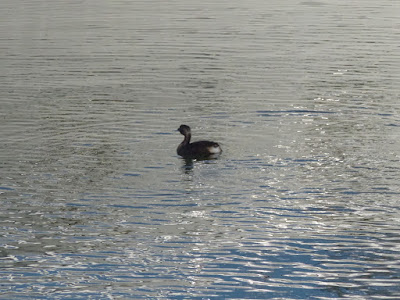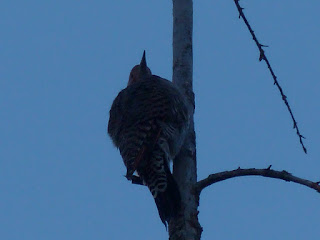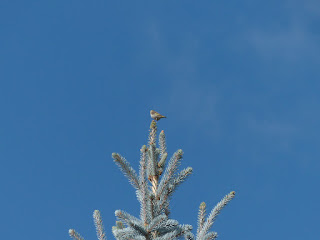When attending an out-of-state wedding and staying in a motel, it's easy to get up and out before the wedding activities start up.
So this is where I did my birding in northern Idaho - Tobe Way teed into Plato Drive. Both were untraveled dirt roads behind the motel (the building with the long green roof) that ran through wildflower, weed and coniferous woodlots. I don't know when this google photo was taken but the conifers seemed much denser than shows up on this satellite map. At the end of Plato Drive is Homestead Loop Drive along which I also walked.
I don't know why I'm describing my little patch in such detail. Frankly, I didn't see much on my three mornings of birding here. Of course, being in a northwestern state I was looking for birds I would not see at home. On this score, I saw three species for sure that met this goal and, with good guessing, maybe a 4th.
On Friday morning, with overcast skies and a lot of haze in the air, I saw this actively hunting Merlin.
A bird tops on my list for seeing is Lewis's woodpecker which, over its big range, is very localized. On any western trip I'm looking for one. On wedding day Saturday morning I had a little more time. I stepped out from the motel grounds on to Tobe Way and, from a distance, I saw the perfect profile of Lewis's woodpecker. I thought, no, too easy. I kept my hopes up as I slowly crept closer and closer. Still closer and less backlit, I finally got close enough to see a Northern Flicker - red-shafted, of course. Otherwise, looks and sounds the same as our yellow-shafted.
I saw a square-tailed dove perched on a utility pole along Homestead Loop Road. It's startling to see how extensively Eurasian-collared doves now occupy the U.S.
Along Homestead Loop Road
Handsome horse.
Pine siskens were present and heard almost everywhere all weekend.
Couldn't resist chicken crossing the road.
Above and below: what is this? A little narrative is required. All three mornings I saw feeding chickadee flocks of about a dozen or so birds and from which I was able to pick out mountain chickadees from the mostly black-capped. As always they were continuously moving and this situation is always going to be difficult for me with my kind of camera. I spent many frames making poor photographs of moving chickadees hoping that one of the photos would be a mountain chickadee. When I got home I had time to focus on my photos. I came across these two. What in heaven's name?
Red-breasted nuthatches were also common all three mornings. I don't recall seeing or hearing white-breasted nuthatches, although according to range maps they are here. I never saw one, but chestnut-backed chickadee is also found in coniferous northern Idaho.
So, what is this bird? I'll never know for sure, but I am thinking chestnut-backed chickadee and nuthatch hybrid. And which nuthatch? Again, will never know, but maybe white-breasted. I included the photo below because the chestnut flank is well seen as well as is the bird's largish bill. Also, in the top photo, look at how the bird is holding a seed in its bill. Nuthatch-style. Comments invited.
This is the closest I may have come to photographing a mountain chickadee. Sibley describes the white supercilium as being unique but sometimes indistinct.
I saw mountain bluebirds along the fence line of an agricultural field. To my dismay too far away for photographs. On my final morning, a robin-sized bird with an upcocked tail flew low into some underbrush. I guessed spotted towhee.
A not uncommon sight in northern Idaho.


























































